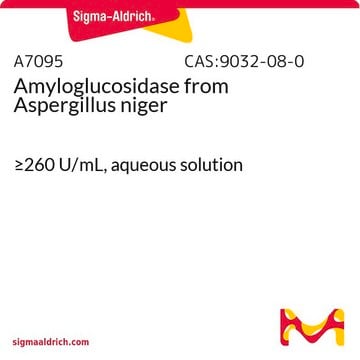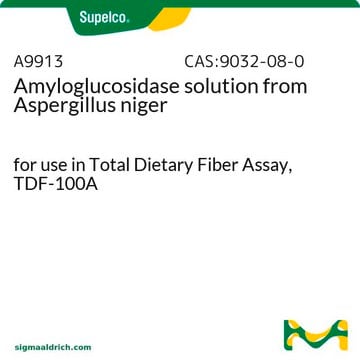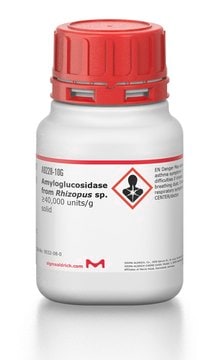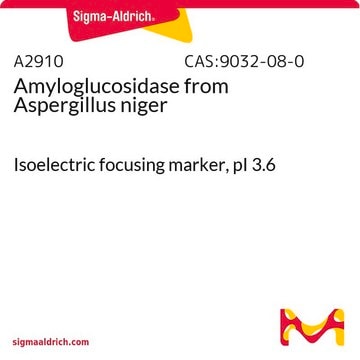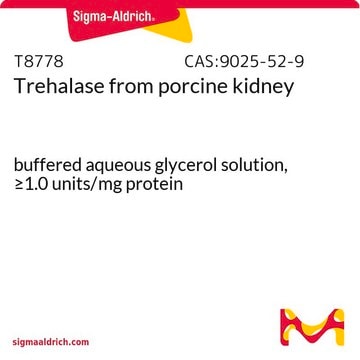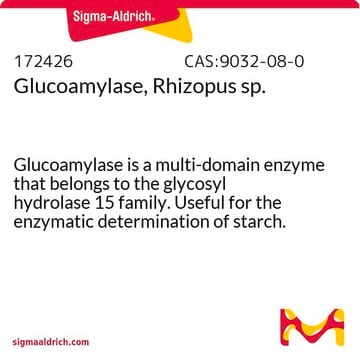This product is filled by density, with a target fill volume of 0.5 ml for the 25mg and 2.0 ml for the 100mg package sizes.
A1602
Amyloglucosidase from Aspergillus niger
ammonium sulfate suspension, ≥40 units/mg protein
Synonyme(s) :
1,4-α-D-Glucane glucohydrolase, Exo-1,4-α-glucosidase, Glucoamylase
Sélectionner une taille de conditionnement
125.00 CHF
Date d'expédition estimée le16 avril 2025
Sélectionner une taille de conditionnement
About This Item
125.00 CHF
Date d'expédition estimée le16 avril 2025
Produits recommandés
Forme
ammonium sulfate suspension
Niveau de qualité
Activité spécifique
≥40 units/mg protein
Conditions d'expédition
wet ice
Température de stockage
2-8°C
Vous recherchez des produits similaires ? Visite Guide de comparaison des produits
Description générale
Application
Actions biochimiques/physiologiques
Définition de l'unité
Forme physique
Autres remarques
Code de la classe de stockage
12 - Non Combustible Liquids
Classe de danger pour l'eau (WGK)
WGK 2
Point d'éclair (°F)
Not applicable
Point d'éclair (°C)
Not applicable
Équipement de protection individuelle
Eyeshields, Gloves, multi-purpose combination respirator cartridge (US)
Faites votre choix parmi les versions les plus récentes :
Certificats d'analyse (COA)
Vous ne trouvez pas la bonne version ?
Si vous avez besoin d'une version particulière, vous pouvez rechercher un certificat spécifique par le numéro de lot.
Déjà en possession de ce produit ?
Retrouvez la documentation relative aux produits que vous avez récemment achetés dans la Bibliothèque de documents.
Les clients ont également consulté
Articles
Instructions for working with enzymes supplied as ammonium sulfate suspensions
Protocoles
This procedure may be used for the determination of Amyloglucosidase activity using starch as the substrate.
-
What volume of ammonium sulfate is the 25mg suspended in?
1 answer-
Helpful?
-
-
How can a 1mg/mL solution of amyloglucosidase A1602 be prepared in acetate buffer?
1 answer-
The product A1602 is in an ammonium sulfate solution. Here's how you can work with this product:
- If the ammonium sulfate might interfere with the reaction(s):
1. Remove the enzyme from the refrigerator, ensuring that the ammonium sulfate suspensions are not frozen.
2. Gently invert the vial or bottle to produce a milky suspension. Avoid using harsh treatments like vortexing or sonicating, as they may denature some of the enzyme.
3. Use a pipette and sterile wide-bore pipette tip to remove a portion of the suspension.
4. Transfer the portion to a clean microcentrifuge or centrifuge tube.
5. Pellet the enzyme by centrifuging at approximately 10,000 – 15,000 x g for 10 minutes, if possible, using a refrigerated microcentrifuge set to a temperature between 2 °C and 8 °C.
6. Carefully remove as much clear supernatant as possible, retaining it; it is not necessary to remove absolutely all of the ammonium sulfate solution.
7. Dissolve the pellet by adding an appropriate amount of reaction buffer.
8. Assay the supernatant and the solution from the pellet for protein content and/or enzyme activity.- If the ammonium sulfate will not interfere with the reaction(s), follow the same steps as above.
It's important to note that for an ammonium sulfate suspension, most of the enzyme will be in solid form, and only negligible amounts of enzyme will likely be in the ammonium sulfate solution.
Alternatively, there are several Amyloglucosidase enzymes available in solid form (e.g., Product A7420 and A9228) that can be suspended in a solvent of your choice.
Helpful?
-
Active Filters
Notre équipe de scientifiques dispose d'une expérience dans tous les secteurs de la recherche, notamment en sciences de la vie, science des matériaux, synthèse chimique, chromatographie, analyse et dans de nombreux autres domaines..
Contacter notre Service technique